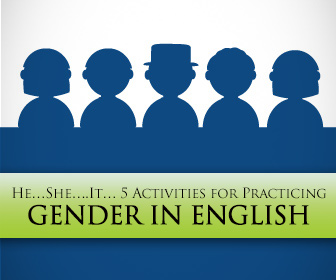Getting (Politically) Correct: 3 Simple Tips for Using Unbiased Language


I remember thinking, “Is book feminine or masculine? Does a book even have a gender? Why does this have to be so complicated?” It was frustrating at the time, but now I have a greater appreciation of language structure and a deeper understanding of why nouns have gender to begin with. English, unlike French, Spanish and many other languages, does not assign gender to inanimate objects (for the most part, anyway). Our students, then, should have an easy time with gender words in English, right? Wrong. Gender differences still apply, and you might be surprised to see how many gender differences are present in English. ESL students need activities in which they can practice gender these words. Here are some of my favorites that you can use with your ESL class, too.

Many words in English are male or female specific. Words like husband, father, nephew and groom all refer to men. Other words like wife, mother, niece and bride only refer to women. Still other words can refer to either men or women: cousin, spouse, sibling, etc. As a class, work together to brainstorm all the different words for referring to a person that are gender specific. It may help to think in terms of roles a person plays in a family or relationship. Working together, make three lists of gender specific words: one for men, another for women and the third for words that can refer to either men or women.
Once you have expanded your list as much as possible, give your students a chance to practice many of these words by creating their family tree. Have students start by diagramming themselves and their parents, and then work backward through their ancestry as far as they can. They should also include aunts, uncles and cousins when possible. You can find a blank family tree template here or have your students design their own. Then have students share about their family with two or three classmates. After each person has shared general information about the members of their family, challenge your students to take their explanations a step further. Have group members choose two members of the speaker’s family. The speaker must then explain the relationship between those two people. For example, a person might explain, “That is my grandfather and that is my cousin. My grandfather is my cousin’s great uncle.” As each person is speaking, encourage his group members to listen for the correct gender words from their classmates.
In English, some adjectives are used primarily for males, others for females. Using this list of positive personality adjectives and this list of negative personality adjectives, have students note any adjectives which are used primarily for women and others used primarily for men. Working in the same groups, challenge students to add any other adjectives they can think of that are gender specific (e.g. beautiful, handsome, etc.) After talking about the traits on the list, give small groups some discussion time. Display the following questions for them to discuss.
Cultural values and expectations are often tied to gender differences. Give your students a chance to talk about the expectations and acceptable behavior of men and women in their own countries and compare it to those of their classmates’ home countries. In groups of four or five, have students discuss the following questions.
After discussing these questions, have your students write an opinion paper arguing whether these gender stereotypes are acceptable or unacceptable. Encourage students to use personal examples when possible to support their opinions.
In recent years, male specific language has fallen out of use. Words like mankind, fireman, mailman, steward and waiter have been replaced with gender neutral words (humankind, firefighter, mail carrier, flight attendant, and server). In groups of three or four, have your students brainstorm as many male specific or female specific words as they can. (Think along the lines of job titles.) Have groups share their lists with the class. Then have groups work together to list the gender neutral forms that speakers use today. Finish out the class with a small group discussion with the following questions.
All persons may be created equal, but not everything is the same when it comes to men and women. Language, behavior and responsibilities are all affected by a person’s gender – some for good and some for ill. Because gender differences can be a controversial topic among your students, these activities will challenge your students to think for themselves and express their opinions, things that are good for getting ESL students talking.
Is it related to their cultures of origin? How do you deal with these differences in class?